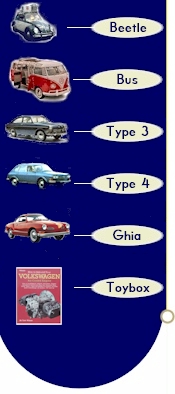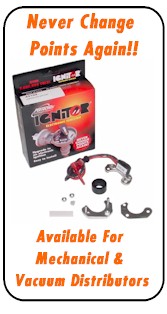What exactly is a Super Beetle?
In 1971 to help compete
against more technologically advanced models from other
manufacturers and also to give the Convertible Beetles a
better-riding platform to use, the Super Beetle was introduced. It
did not replace the standard Beetle and both models were sold
side-by-side.
Super Beetles, at least for the first two years, were just a front
suspension upgrade, from a torsion beam front axle to a MacPherson
strut front suspension. The addition of this new front end
necessitated other changes - essentially all of the sheet metal from
the cowl forward, the tie rods and steering damper were changed, the
steering box, the front brakes were enlarged to help deal with the
extra weight in the front (though in the US they remained drums),
and even the hood molding had to be lengthened due to the new longer
hood. Very few parts from standard Beetles were still used on the
Super Beetle front section - wheels, tires, lights, and bumpers
being the primary items.
In 1973 to further improve the model and to help differentiate it
more aesthetically from the standard Beetle, a curved windshield was
introduced along with a different dash and a slightly flatter
roofline. Various improvements were done to front end a few months
later though it remained a MacPherson strut set-up. The Super Beetle
was discontinued in 1975 as VW moved towards the water-cooled models
though Super Beetle convertibles continued through 1979 (some
entering the US as 1980 models).
Truths and Myths about Super Beetles
Myth #1 - Super
Beetles
have a bigger engine than a standard Beetle
Truth - Super
Beetles
had the exact same engine that standard Beetles had. They were
never faster, bigger, badder, or more efficient. The engines did
not use their own numbering system or any other unique parts.
Myth #2
- Super
Beetles
all had big curved windshields
Truth
- 1971 and 1972 Super Beetles had the "flat" windshield
(well, they weren't truly flat, but lets not go into that here!).
These two years used the same windshield as the standard Beetle.
In 1973, the Super Beetle was redesigned and a new larger, curved
windshield was added. No other Beetle used this windshield.
Myth
#3 - Some
Super Beetles had standard Beetle front ends
Truth
- All Super Beetles came with Macpherson Strut Front Suspensions.
They never, ever, came with any other front end. During the 1973
Model Year, the Macpherson Front Suspension was modified, but it
was still a strut-front suspension. And, no, Standard Beetles
never came with a Strut Front Suspension. The Macpherson Strut
Front is the one thing all Super Beetles had and no Standard Beetle
ever had and is the primary reason they were Super Beetles.Myth #4
- All Convertibles are Super
Beetles
Truth - Only
Convertible Beetles produced from 1971-1979 are Super
Beetles. You
could not order a Standard Beetle Convertible during these years -
they were only based on the Super Beetle platform.
Myth #5
- Only Super Beetles had those
big, round taillights in the 70's.
Truth
- You
will hear a lot of people call the big "Elephant Foot"
taillights "Super Beetle taillights", but this is not
correct. All Beetles from 1973 to 1979 (and through 2003 for
Mexican and Brazilian production), whether they were standard
or Super used this style taillight.
The 2 easiest
ways to tell if your Beetle is a Super Beetle:
(and while there are a lot
of ways to tell if it's a Super Beetle, these are the only two that
are really consistent and easy to spot no matter the year)
- Pop the hood! All
Super Beetles had their spare tire
laying flat.
- Look behind the front wheels
- see a big spring? If you do - you are staring at the
Macpherson Struts and it, thus, is a Super
Beetle.
Common questions
about Super Beetles
Q
- Will this
hood from a 1974 Super Beetle fit my 1971 Super
Beetle.
A
- No. Super Beetles used two distinct hoods. One fit the flat
windshield models and one fit the curved windshield models.
Q
- Did all Super
Beetles use the
same ball joints, struts, etc?
A - The
Super Beetle front end was modified a few times. The Ball Joints
were changed during the 1973 Model Year. The Struts were changed
at the same time. The Struts were changed again in 1975 and the
tie rods were changed at that time too. The Steering Box never
changed until it was done away with in 1975 in favor of a rack and
pinion set-up. The Steering Gear Shaft was changed at the same
time. There were a few other changes here and there. Its important
to know your chassis number when ordering parts, and be familiar
with what the parts on your Super Beetle look like as there are
some gray areas.
Q - What
causes the Super Beetle shakes?
A - There
is a lot of debate on this. Some people feel it is the wheels out
of balance, that the front end needs aligned, the steering damper
is shot, the tie rods are bent, the steering box is worn out and
so on. However, while any of these issues will cause your front
end to handle badly (on any car!), the truth is that none of these
by themselves cause Super Beetle shakes, though they can make them
worse. If your Super Beetle's steering wheel starts shaking round
40 miles an hour and this continues until you get to around 55
(sometimes it starts at lower speeds),
then your Track Control Arm Bushings are worn out. After you
replace these - then you might want to make sure the steering damper is
fine (as it probably got worn out during all this shaking) and of
course, make sure all off your other front end components are in
good shape.
Q - What years were
Super Beetles produced?
A
- They were made from 1971-1979. They were produced in three
versions - Sedan, Sedan with Sunroof, and Convertible. The Sedans
were only made from 1971 to 1975 (and were actually discontinued
about halfway through the 75 model year). The Convertibles were
made from 1971 to 1979 (though you will see a few 1980's in
existence - these are really 79 models that showed up in the US
after the new model year had started and were thus titled as 1980
models).
Q - I want my Super
Beetle
to look more vintage - can I bolt on earlier style fenders?
A
- No. Super Beetle fenders only can
trade out with other Super Beetles, at least on the front. On the
rear, they are no different than standard Beetle fenders of the
same year.
Q - Can I convert my
Super Beetle over to a standard Beetle torsion-leaf front beam?
A
- Good luck with that! Actually, it can be done and we have seen it
but it's a lot of work for no real useful gain
|



